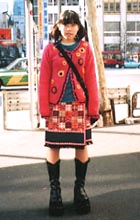FOLK FASHION:
1999 Fall/Winter Style Is a Blockbuster
January 12, 2000
The "in" look making the rounds in fall and winter 1999 is folk fashion,
inspired by ethnic clothing styles from around the world. The clothes
have a warm, homespun appeal and are made of tactilely pleasing materials.
For the past several years, fashion has been dominated by pared-down
looks, from casual sportswear to minimal chic. Now consumers are turning
toward clothing that is soft, both on the eye and to the touch.
Multiethnic Fashion
 |
 |
| |
A Young Tokyoite shows off folk fashion.
|
The ethnic clothing and ornamentation currently in vogue have northern
European, South American, Native American, and Asian influences, among
others. Time-honored handwork techniques from around the world create
the naive appeal seen in felt vests decorated with yarn-embroidered
flowers or with cutwork; sweaters crudely knit from bulky yarn; and
cardigans with sparkling beads, spangles, or mirror pieces sewn on.
The makers use a wide range of materials, such as knit fabric, leather,
suede, velour, and denim, and add decorative touches using embroidery,
fringes, frills, gathers, and ribbons. Coming now, at the end of the
twentieth century, it all seems very retro.
Part of the appeal of folk fashion is that people can readily adapt
it to their personal preferences. Some wearers embrace the ethnic
look from head to toe, while others add a single folksy item to a
sportswear ensemble. The phrase "X-percent folksy" has emerged as
a way of describing the extent to which a person or outfit incorporates
folk elements.
According to trend pundits, this craze was sparked in spring 1999 when folk-inspired designs appeared in the Milan collections. This fashion swiftly made their way into boutiques and department stores in Japan, then suddenly gained widespread currency around May. The hippie styles that became popular in the summer also fell under the heading of folk fashion. When the weather turned cool, young women began wearing arm warmers with the sleeveless knit sweaters whose popularity had been fueled by the lingering summer heat. Once fall arrived in earnest, shoulder warmers (sleeved garments that cover only the shoulders and upper back) and South American ponchos became a common sight on the streets.
Accessories Go Folksy, Too
The folk sensibility has found its way into bags, shoes, hats, and jewelry as well as clothing. The stores are full of bags accented with fur (real or fake) and decorated with feathers, beads, or embroidery. As one might expect, the bags feel good to touch. In the realm of shoes, boots became popular. Unlike a previously popular look--long boots worn with miniskirts--folk fashion hides the tops of the long boots with a long or knee-length skirt. A whole slew of elaborately designed boots made of leather, suede, or sheepskin and decorated with fake fur trimming or fringes are coming out. As for jewelry, folk fashion devotees are crazy about feathers. Some of the favorites are leather cord necklaces with just two or three feathers strung onto it and earrings with a single feather, usually 5 to 7 centimeters (2 to 2.8 inches) long, dangling on each side.
Folk fashion encompasses a wide variety of materials, colors, and designs. But one common element is a relaxed fit and freedom from physically confining elements. This is the polar opposite of so-called bodikon (short for "body-conscious") fashion--the form-fitting minidresses that were all the rage 10 years ago. Soft, gentle folk fashion lets the wearer breathe a sigh of relief, and it seems likely that people will continue to enjoy it for some time.
 Edited
by Japan Echo Inc. based on domestic Japanese news sources. Articles presented
here are offered for reference purposes and do not necessarily represent
the policy or views of the Japanese Government.
|



















